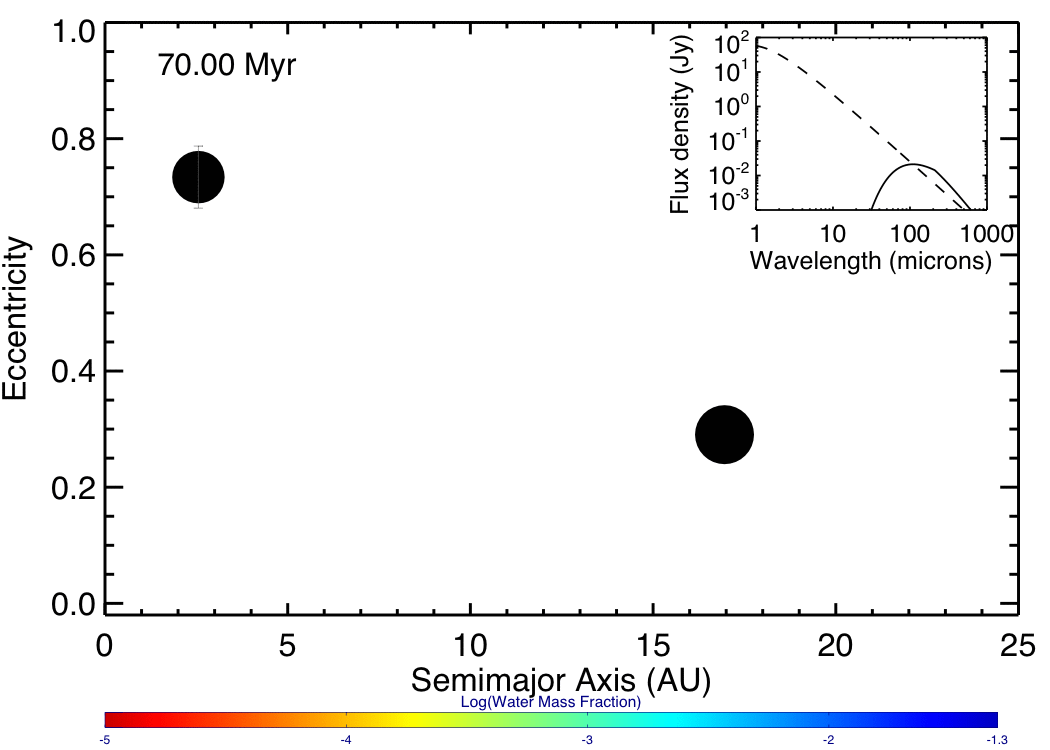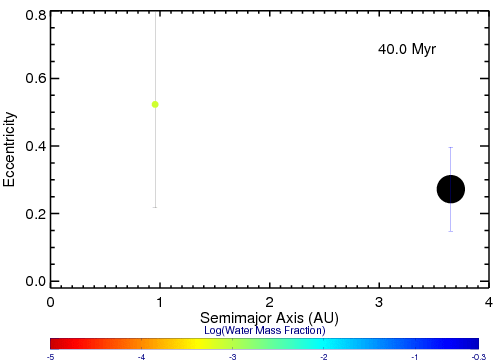BACK TO SEAN'S MAIN PAGE
Debris disks as signposts of terrestrial planet formation (with movies!)
Planetary systems are complex, and there is a lot of physics that determines how circumstellar disks of gas and dust produce planets. One simple way to think about disks is by combining formation timescales and disk masses. A disk with a typical density profile can be broken up into three different zones: an inner zone that forms terrestrial planets because it doesn't have enough mass to form the 5-10 Earth mass cores needed to accrete gas and become gas giants, a middle zone where gas giant planets can and do form, and an outer zone with a significant amount of mass that simply doesn't have enough time to grow giant planet cores before the gas disk goes away (see e.g., Kokubo & Ida 2002 for more on this idea).
With this in mind, Phil Armitage and I ran simulations that included three different components: a) an inner region of planetary embryos and planetesimals from 0.5-4 AU that, left to themselves, produce terrestrial planets that look something like the Solar System's; b) three giant planets from roughly 5-10 AU that, when they become unstable, reproduce the eccentricity distribution of known extra-solar planets; and c) a 10 AU-wide outer disk of planetesimals that is comparable to the Solar System's primordial Kuiper Belt (pre-Late Heavy Bombardment).
The main result from these simulations is that the survival of the outer disk of planetesimals correlates strongly with the formation of terrestrial planets, simply because both populations are at the mercy of the gravitational perturbations of the giant planets. So, when the giant planets become unstable (as probably happens in *most* systems -- gory details can be found in section 5 of Raymond et al 2010), they disrupt both terrestrial planet formation as well as the outer planetesimal disks. Dust produced in such disks is detectable via an infrared excess -- these are called "debris disks". This result motivated me to claim that stars older than roughly 100 million years with debris disks may act as "signposts" for systems with terrestrial planets. The two papers on this subject are Raymond et al 2011 and Raymond et al 2012.
On to the movies! Each movie shows a population of objects in orbit around a central star, assumed here to be Sun-like. The x axis is the semimajor axis and the y axis is the orbital eccentricity -- the sine of the inclination is also shown as the "error bar" for large planets with i > 10 degrees. The size of each body is representative of its mass and increases as the mass to the 1/3rd power. The color of objects correspond to their water contents, although that is more relevant for the water delivery simulations. The black circles at 5-10 AU are the giant planets; their masses are not on the same scale as the small bodies.
This first movie, from Raymond et al 2012, shows a system where the giant planets go unstable and destroy everything, leaving behind a pair of giant planets on quite eccentric orbits. The inset in the top right shows the SED of dust produced by planetesimals in the system: the stellar photosphere is shown with the dashed line.

The next movie shows a simulation from Raymond et al 2011 in which the giant planets went unstable but one terrestrial planet survived on a very peculiar orbit. The orbital eccentricity of this 0.7 Earth mass planet (at 0.91 AU) oscillates between about 0.35 and 0.75, and its orbital inclination (shown with the vertical "error bars") orscillates between zero and more than 60 degrees every 10,000 years! The climate on such a planet is likely to be very interesting (see this movie from Spiegel et al 2010)!

Finally, here are two movies from Raymond et al 2012 in which different parameters for the simulations have been changed. In the movie on the left, the outer planetesimal disk contains five "seeds" of 2 Earth masses each. These seeds interact gravitationally with the outer disk of planetesimals, causing the disk to spread out radially and to become colder. The system eventually goes unstable but 2 terrestrial planets survived. In the movie on the right, the giant planets are closer to ice giants than gas giants and have masses of just 15-50 Earth masses. The outermost giant planets migrates outward by planetesimal-driven migration, leaving a belt of planetesimals trapped in between the two inner giant planets and the outer one. This movie doesn't contain the dust SED of the system but I just made a new version that does. It is a large file (78 MB) and you can see or download it here.


This work was done in collaboration with frequent collaborator extraordinaire Phil Armitage as well as Amaya Moro-Martin, Mark Booth, Mark Wyatt, John Armstrong, Avi Mandell, Franck Selsis, and my best bud and statistical master Andrew West.
BACK TO MAIN PAGE



